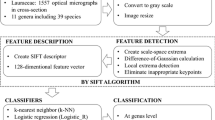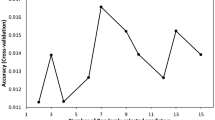Abstract
This paper describes a computer vision approach to automated rapid-throughput taxonomic identification of stonefly larvae. The long-term objective of this research is to develop a cost-effective method for environmental monitoring based on automated identification of indicator species. Recognition of stonefly larvae is challenging because they are highly articulated, they exhibit a high degree of intraspecies variation in size and color, and some species are difficult to distinguish visually, despite prominent dorsal patterning. The stoneflies are imaged via an apparatus that manipulates the specimens into the field of view of a microscope so that images are obtained under highly repeatable conditions. The images are then classified through a process that involves (a) identification of regions of interest, (b) representation of those regions as SIFT vectors (Lowe, in Int J Comput Vis 60(2):91–110, 2004) (c) classification of the SIFT vectors into learned “features” to form a histogram of detected features, and (d) classification of the feature histogram via state-of-the-art ensemble classification algorithms. The steps (a) to (c) compose the concatenated feature histogram (CFH) method. We apply three region detectors for part (a) above, including a newly developed principal curvature-based region (PCBR) detector. This detector finds stable regions of high curvature via a watershed segmentation algorithm. We compute a separate dictionary of learned features for each region detector, and then concatenate the histograms prior to the final classification step. We evaluate this classification methodology on a task of discriminating among four stonefly taxa, two of which, Calineuria and Doroneuria, are difficult even for experts to discriminate. The results show that the combination of all three detectors gives four-class accuracy of 82% and three-class accuracy (pooling Calineuria and Doro-neuria) of 95%. Each region detector makes a valuable contribution. In particular, our new PCBR detector is able to discriminate Calineuria and Doroneuria much better than the other detectors.
Similar content being viewed by others
References
Arbuckle, T., Schroder, S., Steinhage, V., Wittmann, D.: Biodiversity informatics in action: identification and monitoring of bee species using ABIS. In: Proceedings of the 15th International Symposium Informatics for Environmental Protection, vol. 1, pp. 425–430. Zurich (2001)
Bouchard, G., Triggs, B.: Hierarchical part-based visual object categorization. In: IEEE Conference on Computer Vision and Pattern Recognition, pp. I 710–715 (2005). http://lear.inrialpes.fr/pubs/2005/BT05
Breiman, L.: Bagging predictors. Mach. Learn. 24(2), 123–140 (1996). http://citeseer.ist.psu.edu/breiman96bagging.html
Breiman L., Friedman J., Olshen R. and Stone C. (1984). Classification and Regression Trees. Chapman and Hall, New York
Burl, M., Weber, M., Perona, P.: A probabilistic approach to object recognition using local photometry and global geometry. In: Proceedings of the ECCV, pp. 628–641 (1998)
Carter J., Resh V., Hannaford M. and Myers M. (2006). Macroinvertebrates as biotic indicators of env. qual. In: Hauer, F. and Lamberti, G. (eds) Methods in Stream Ecology, pp 1–2. Academic, San Diego
Csurka, G., Dance, C., Fan, L., Williamowski, J., Bray, C.: Visual categorization with bags of keypoints. ECCV’04 workshop on Statistical Learning in Computer Vision, pp. 59–74 (2004)
Csurka, G., Bray, C., Fan, C.L.: Visual categorization with bags of keypoints. ECCV workshop (2004)
Do M., Harp J. and Norris K. (1999). A test of a pattern recognition system for identification of spiders. Bull. Entomol. Res. 89(3): 217–224
Dorko, G., Schmid, C.: Object class recognition using discriminative local features. INRIA—Rhone-Alpes, RR-5497, February, 2005, Rapport de recherche. http://lear.inrialpes.fr/pubs/ 2005/DS05a
Dorkó, G., Schmid, C.: Object class recognition using discriminative local features (2005). http://lear.inrialpes.fr/pubs/2005/DS05. Accepted under major revisions to IEEE Trans. Pattern Anal. Mach. Intell. (updated 13 September)
Fergus, R., Perona, P., Zisserman, A.: Object class recognition by unsupervised scale-invariant learning. In: Proceedings of the IEEE Conference on Computer Vision and Pattern Recognition, vol.~2, pp. 264–271. Madison, Wisconsin (2003)
Freund, Y., Schapire, R.E.: Experiments with a new boosting algorithm. In: International Conference on Machine Learning, pp. 148–156 (1996). http://citeseer.ist.psu.edu/freund96experiments.html
Friedman, J., Hastie, T., Tibshirani, R.: Additive logistic regression: a statistical view of boosting (1998). http://citeseer.ist.psu. edu/friedman98additive.html
Gaston K.J. and O’Neill M.A. (2004). Automated species identification: why not?. Philosophical Trans. R. Soc. B: Biol. Sci. 359(1444): 655–667
Harris, C., Stephens, M.: A combined corner and edge detector. Alvey Vision Conference, pp. 147–151 (1988)
Hilsenhoff W.L. (1988). Rapid field assessment of organic pollution with a family level biotic index. J. North Am. Benthol. Soc. 7: 65–68
Hopkins G.W. and Freckleton R.P. (2002). Declines in the numbers of amateur and professional taxonomists: implications for conservation. Anim. Conserv. 5(3): 245–249
Jurie F. and Schmid C. (2004). Scale-invariant shape features for recognition of object categories. CVPR 2: 90–96
Jurie, F., Triggs, B.: Creating efficient codebooks for visual recognition. In: ICCV ’05: Proceedings of the 10th IEEE International Conference on Computer Vision (ICCV’05), vol. 1, pp. 604–610. IEEE Computer Society, Washington, DC, USA (2005). DOI http://dx.doi.org/10.1109/ICCV.2005.66
Kadir, T., Zisserman, A., Brady, M.: An affine invariant salient region detector. In: European Conference on Computer Vision (ECCV04), pp. 228–241 (2004)
Kumar, S., August, J., Hebert, M.: Exploiting inference for approximate parameter learning in discriminative fields: an empirical study. In: 5th International Workshop, EMMCVPR 2005, pp. 153–168. Springer, St. Augustine (2005)
Landwehr, N., Hall, M., Frank, E.: Logistic model trees. Mach. Learn. 59(1–2), 161–205 (2005). DOI 10.1007/s10994-005- 0466-3
Leibe, B., Seemann, E., Schiele, B.: Pedestrian detection in crowded scenes. In: CVPR ’05: Proceedings of the 2005 IEEE Computer Society Conference on Computer Vision and Pattern Recognition (CVPR’05), vol. 1, pp. 878–885. IEEE Computer Society, Washington, DC, USA (2005). DOI http://dx.doi.org/10.1109/CVPR.2005.272
Lowe, D.G.: Distinctive image features from scale-invariant keypoints. Int. J. Comput. Vis. 60(2), 91–110 (2004). DOI 10.1023/B:VISI.0000029664.99615.94
Lucas, S.: Face recognition with continuous n-tuple classifier. In: Proceedings of the British Machine Vision Conference, pp. 222–231. Essex (1997)
Matas J., Chum O., Urban M. and Pajdla T. (2004). Robust wide- baseline stereo from maximally stable extremal regions. Image Vis. Comput. 22(10): 761–767
Mikolajczyk K. and Schmid C. (2002). An affine invariant interest point detector. ECCV 1(1): 128–142
Mikolajczyk K. and Schmid C. (2004). Scale and affine invariant interest point detectors. IJCV 60(1): 63–86
Mikolajczyk, K., Tuytelaars, T., Schmid, C., Zisserman, A., Matas, J., Schaffalitzky, F., Kadir, T., Gool, L.V.: A comparison of affine region detectors. IJCV 65(1/2), 43–72 (2005). http://lear.inrialpes.fr/pubs/2005/MTSZMSKG05
O’Neill, M.A., Gauld, I.D., Gaston, K.J., Weeks, P.: Daisy: an automated invertebrate identification system using holistic vision techniques. In: Proceedings of the Inaugural Meeting BioNET-INTERNATIONAL Group for Computer-Aided Taxonomy (BIGCAT), pp. 13–22. Egham (2000)
Opelt, A., Fussenegger, M., Pinz, A., Auer, P.: Weak hypotheses and boosting for generic object detection and recognition. In: 8th European Conference on Computer Vision, vol. 2, pp. 71–84. Prague, Czech Republic (2004)
Opelt A., Pinz A., Fussenegger M. and Auer P. (2006). Generic object recognition with boosting. IEEE Trans. Pattern Anal. Mach. Intell. 28(3): 416–431
Papageorgiou C. and Poggio T. (2000). A trainable system for object detection. Int. J. Comput. Vis. 38(1): 15–33
Quattoni, A., Collins, M., Darrell, T.: Conditional random fields for object recognition. In: Proceedings of the NIPS 2004. MIT Press, Cambridge (2005)
Quinlan J.R. (1993). C4.5: programs for machine learning. Morgan Kaufmann, San Francisco
Shotton, J., Blake, A., Cipolla, R.: Contour-based learning for object detection. In: ICCV ’05: Proceedings of the 10th IEEE International Conference on Computer Vision (ICCV’05), vol. 1, pp. 503–510. IEEE Computer Society, Washington, DC, USA (2005). DOI http://dx.doi.org/10.1109/ICCV.2005.63
Sokal, R.R., Rohlf, F.J.: Biometry, 3rd edn. W. H. Freeman, Gordonsville (1995)
Steger C. (1998). An unbiased detector of curvilinear structures. PAMI 20(2): 113–125
Sung K.K. and Poggio T. (1998). Example-based learning for view-based human face detection. IEEE Trans. Pattern Anal. Mach. Intell. 20(1): 39–51
Turk, M.A., Pentland, A.P.: Face recognition using eigenfaces. In: Proceedings of IEEE Conference on Computer Vision and Pattern Recognition, pp. 586–591 (1991)
Tuytelaars, T., Gool, L.V.: Wide baseline stereo matching based on local, affinely invariant regions. BMVC, pp. 412–425 (2000)
Tuytelaars T. and Gool L.V. (2004). Matching widely separated views based on affine invariant regions. IJCV 59(1): 61–85
Vincent L. and Soille P. (1991). Watersheds in digital spaces: an efficient algorithm based on immersion simulations. PAMI 13(6): 583–598
Zhang, W., Deng, H., Dietterich, T.G., Mortensen, E.N.: A hierarchical object recognition system based on multi-scale principal curvature regions. International Conference of Pattern Recognition, pp. 1475–1490 (2006)
Author information
Authors and Affiliations
Corresponding author
Rights and permissions
About this article
Cite this article
Larios, N., Deng, H., Zhang, W. et al. Automated insect identification through concatenated histograms of local appearance features: feature vector generation and region detection for deformable objects. Machine Vision and Applications 19, 105–123 (2008). https://doi.org/10.1007/s00138-007-0086-y
Received:
Accepted:
Published:
Issue Date:
DOI: https://doi.org/10.1007/s00138-007-0086-y




